
19.1.6 Monitoring
The temperatures mentioned in chapter 01., section 01.2, should
not be exceeded.
Pressure gauges on the instrument panel indicate HT and LT
pressures after the pumps. The pressures depend on the speed
and the installation. Guidance values, see chapter 01., section
01.2.
The HT water outlet after the engine is provided with an alarm
switch and depending on installation with a stop switch. Main
engines are provided with alarm switches for low HT and LT
pressure.
For further information, see chapter 23.
19.2
Maintenance
19.2.1 General
The installation — including expansion, venting, preheating,
pressurizing — should be carried out strictly according to the
instructions of the engine manufacturer to obtain correct and
trouble free service.
The cooling water should be treated according to the recommen-
dations in chapter 02., section 02.3, to prevent corrosion and
deposits.
If risk of frost occurs, drain all cooling water spaces. Avoid
changing the cooling water. Save the discharged water and use it
again.
Remember to close the drain and open the cooling water connec-
tions before the engine is started again.
19.2.2 Cleaning
In completely closed systems the fouling will be minimal if the
cooling water is treated according to the instructions in chapter
02., section 02.3. Depending on the cooling water quality and the
efficiency of the treatment, the cooling water spaces will foul more
or less over the course of time. Deposits on cylinder liner water
jackets, cylinder heads and cooler stacks should be removed as
they may disturb the heat transfer to the cooling water and thus
cause serious damage.
The need of cleaning should be examined, especially during the first
year of operation. This may be done by overhauling a cylinder liner
and checking for fouling and deposits on the water jacket and block.
The deposits can be of the most various structures and consis-
tencies. In principle, they can be removed mechanically and/or
chemically as described below. More detailed instructions for
cleaning of coolers are stated in chapter 18., section 18.5.
32-200050
Cooling Water System
19
WÄRTSILÄ 32
19 - 3
Summary of Contents for VASA 6L32
Page 4: ......
Page 18: ...Appendix B Welding Precautions 200640 00 6...
Page 26: ...01 Main Data Operating Data and General Design 32 200634 01 01 8 W RTSIL 32...
Page 60: ...Appendix A Environmental Hazards 200507 02A 10...
Page 68: ...Page 7 7 Document No 4V92A0645 Rev j...
Page 84: ...03 Start Stop and Operation 32 200402 04 03 12 W RTSIL 32...
Page 98: ...04 Maintenance Schedule 32 200623 01 04 14 W RTSIL 32...
Page 154: ...07 Tightening Torques and Use of Hydraulic Tools 32 200643 01 07 30 W RTSIL 32...
Page 162: ...08 Operating Troubles Emergency Operation 32 200402 01 08 8 W RTSIL 32...
Page 164: ...Specific Installation Data 2005 01 09 2...
Page 178: ...10 Engine Block with Bearings Oil Sump and Cylinder Liner 32 200150 10 14 W RTSIL 32 34SG...
Page 216: ...Appendix A Testing of cylinder tightness 32 200142 A 4 W rtsil 20 32 34...
Page 226: ...13 Camshaft Driving Gear 32 200546 02 13 10 W RTSIL 32...
Page 254: ...15 Turbocharging and Air Cooling 32 200549 10 15 20 W RTSIL 32...
Page 274: ...16 Injection System 32 200627 01 16 20 W RTSIL 32...
Page 280: ...Fuel System 32 200508 07 17 6 W RTSIL 32...
Page 314: ...19 Cooling Water System 32 200050 19 14 W RTSIL 32...
Page 394: ...23 Instrumentation and Automation 32 200115 II 23 60 W RTSIL 32...
















































